 |
| Blue-Throated Toucanet |
One of the reasons I was really excited about Costa Rica was its birds. From what I had read, I pictured a Utopian world where colorful birds would be flying over our heads, singing beautiful songs. My imagination had built all this up to the extent that I was afraid that I would be disappointed upon getting there.
When we landed in San Jose, I was hoping to start seeing these exotic birds immediately. And we were in fact greeted by three different songs. It took us a few minutes to figure out the source of the songs. And one by one we managed to trace the songs to the singers. The trail, however, all led to one single source - the Great-Tailed Grackle, also known as the Zanate. This versatile bird is often considered a pest because of its loud vocalizations and craftiness. It feeds on grains and can damage agriculture. However, the San Jose city was musical because of the songs of this bird. While there were a few other birds too, the Grackle by far overshadowed them.
 |
| Great-tailed Grackle |
It was when we went to the Irazu volcano, when we saw a variety of birds, including a bunch of hummingbirds. We have already talked about the hummingbirds at length in another post. Here we will talk about other birds. Let's start with the Motmots. These colorful birds belong to the same family of birds as the kingfishers, bee-eaters, and rollers. These birds are a common sight in Costa Rica and you will often find them sitting on the power lines along the roads. The birds nest on the ground and are seen as commonly in the cities as in the forests. And since these birds are not too timid, we managed to capture some good pictures. One particular motmot, in fact, came and sat very close to the trail we were following in Monteverde and struck some beautiful poses.
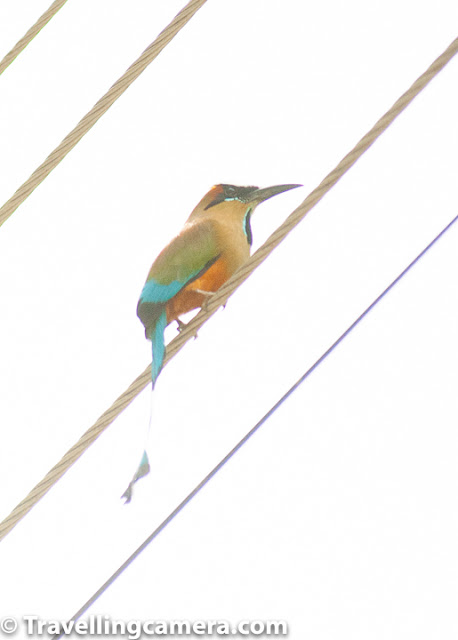 |
| Turquoise-Browed Motmot |
In Costa Rica, we saw two types of Motmots in San Jose as well as in Monteverde - the turquoise-browed motmot and the blue-diademed motmot (also known as Lesson's Monteverde). Both these species have a racket tail, making them quite easy to identify even from a distance. The Turquoise-browed motmot has tail feathers that are bright blue and black in both female and male. In the male motmot, this tail is often the key to success in mating, whereas both male and female motmots also use a wag-display motion to warn of the presence of predators.
 |
| Turquoise-Browed Motmot (seems to have lost its raquet tail) |
The Turquoise-browed motmot's body is mostly green-blue with rufus back and belly. It has a turquoise blue patch on head and cheek. This is a medium-sized bird that feeds on insects and small reptiles. Poison-dart frogs also find themselves being ingested by these birds.
 |
| Blue-Diademed Motmot (Lesson's Motmot) |
The blue-diademed motmot has a blue-green body. It wears a black mask with bright-blue band around it. The blue-diademed motmot is a little harder to sight than the Turquoise-browed motmot because it likes to dwell in dense forests. The tail racquets too are smaller and less dramatic than those of the Turquoise-browed motmot.
Related Blogpost from Costa Rica - Teatro Nacional de Costa Rica in San Jose City of Costa Rica, Central America
 |
| Blue-Throated Toucanet |
Next, let's talk about the toucans and toucanets. While we were only able to see one single toucan, that also from a distance, we were especially lucky when it comes to sighting toucanets. On our very first day in Monteverde, Toucanets made an appearance right outside our homestay. These turned out to be the blue-throated toucanets.
Related Blog-post from Costa Rica - Incredible Birds of Costa Rica - Part 1 || Hummingbirds
 |
| Emerald Toucanet |
The bill is large, though much smaller than that of a toucan. The upper mandible is part yellow. They have a blue patch around the base of the beak and the throat. The body is various shades of green. The vent and tips of the tail are rufus. We again came across toucans inside the Monteverde cloud forest. This time it was most probably the emerald toucanet, though we could not be sure because these were moving about very fast and were at a distance.
Related Blogpost from Costa Rica - Hiking around Blanca Beach around Four Seasons Resort in Papagayo Peninsula, Costa Rica
 |
| Orange-Bellied Trogon |
Trogons were another species of birds that we came across in Costa Rica. We saw this bird in Monteverde as well as in Papagayo peninsula. The bird is large and has an orange belly. This was earlier categorized as a subspecies of the collared trogon, but is now considered a morph instead. The only characteristic that can be used to differentiate between the orange-bellied trogon and the collared trogon is the color of the belly. It is lighter in orange-bellied trogon and much brighter in collared. The neck and back of the orange-bellied trogon is blue-green.
Other Blogpost from Costa Rica - Tour of our room at Four Seasons Papagayo Peninsula, Costa Rica
 |
| Resplendent Quetzal (Male) |
Another bird of the trogon family that we were fortunate enough to sight was the Resplendent Quetzal. This bird needs no introduction. This bird attracts myths and tourists alike. You may find this difficult to believe, but you only have to see this bird once to know what I mean. The bird's plumage is such that it seems to change colors in different lights. The male is so splendidly colored that it is difficult to believe that such a bird can exist.
Related Blog-post from Costa Rica - Travel Guide for Monteverde Cloud Forest Reserve, Costa Rica - Pura Vida !
 |
| Male Resplendent Quetzal at its man-made nest |
We were hoping that we would run into this bird in the cloud forest of Monteverde. Our time in the reserve was almost about to end and we were fast losing hope, when I decided to ask a random tourist whether they had had the opportunity to sight the Resplendent Quetzal. And that gentleman broke into a wide smile and shared a photograph that he had managed to click. The sighting had happened a at a short distance from where we were standing. He gave us detailed instructions about how to get there.
Related Blog-post from Costa Rica - Things not to miss in & around Jaco Town of Costa Rica - Beaches, Birds & Landscapes
 |
| Resplendent Quetzal (Female) |
We reached the spot and were able to see the nest. However, the Quetzals (male or female), were nowhere to be seen. We waited around the area for about 1.5 hours when we saw first the female and then the splendid male. Quetzals are attentive parents and do not leave their nests unattended for too long. We knew this and were confident that we would be able to see them. And thank God we were not disappointed. One of the main reasons to go to Monteverde was to see this bird. Our goal was reached.
Related Blogpost from Costa Rica - Snorkeling & Catamaran ride in Pacific Ocean, Costa Rica
 |
| Female Resplendent Quetzal at the nest |
During our day excursion to the Jaco beach, we were fortunate enough to see the Scarlet Macaw. As is common, we heard the bird before we saw it. Its rude screech made us stop in our tracks and search the canopies overhead. Despite its bright red, blue, and yellow plumage, it wasn't easy to sight this bird. It was out their in plain sight and still managed to camouflage itself. But our patience was rewarded and we soon saw this big parrot looking down at us. Clicking a good photo was another challenge and our camera didn't help much. We did the best we could and moved on.
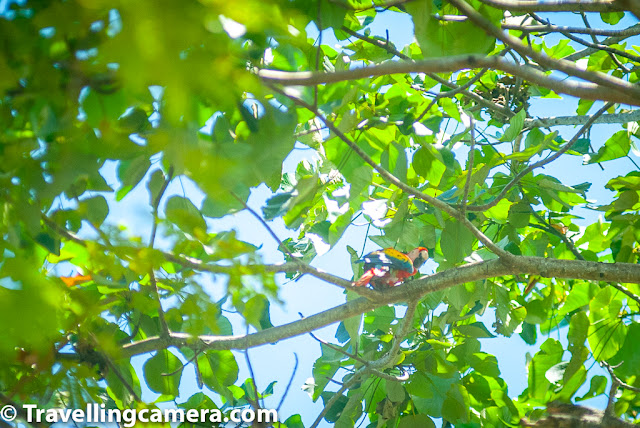 |
| Scarlet Macaw looking down upon us |
In this part, we have mostly talked about the bigger birds so far, but Costa Rica is home to some really beautiful smaller birds. We will talk about those in the next post. In the meanwhile, we will look forward to your comments on this. And if we have made a mistake in identifying any birds, please do feel free to correct us.
 |
| Scarlet Macaw taking a flight |
Related Blogposts -








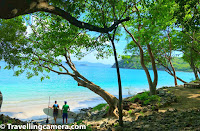
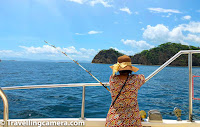





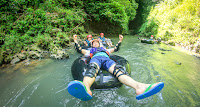



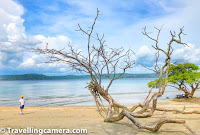

.jpg)
Comments